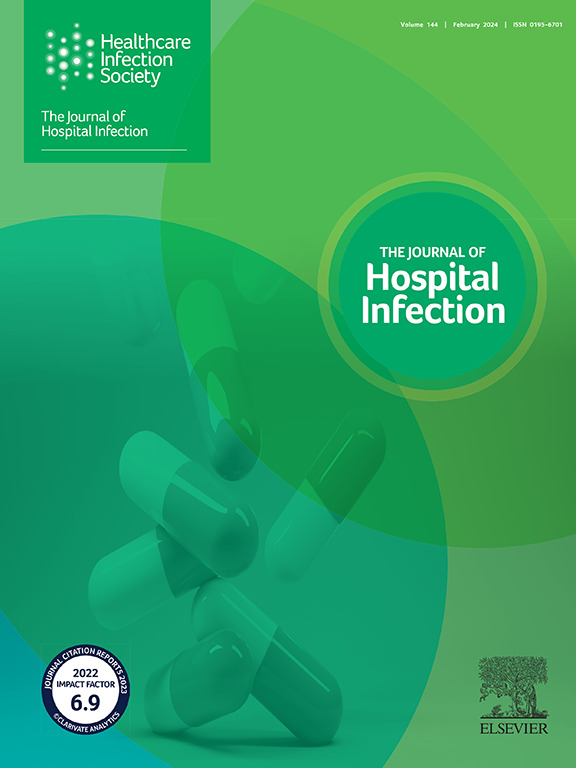一种新颖的手套箱设计,减少了手套箱表面污染和手套浪费。
IF 3.1
3区 医学
Q1 INFECTIOUS DISEASES
引用次数: 0
摘要
背景:非无菌的一次性医用手套对于降低卫生保健环境中交叉污染的风险至关重要。然而,手套箱和未使用的手套可能在脱手套过程中受到污染,从而可能增加病原体传播的风险。目的:本研究比较了一种新型手套箱和一种标准手套箱的手套箱表面污染和手套丢失情况。方法:在Medline Industries LP进行的一项非盲非随机研究中,30名成年参与者戴上涂有手指漆的手套,并从两个手套箱中取出手套,每个盒子分配两名参与者。参与者在尝试125次拉手套或将所有手套从盒子中取出后停止。根据需要重新涂抹手指颜料,或者每隔25次拉手套尝试后重新涂抹手指颜料。通过手指涂料覆盖盒表面(内、外、总)来评估表面污染。手套损失是通过从每个盒子中的手套总数中减去总拉手套次数来测量的。统计分析采用配对Student’st检验和Wilcoxon sign -rank检验,结果P < 0.05。结果:与标准手套箱相比,新型手套箱的内表面(P = 0.0006)和总表面(P = 0.0328)的污染明显减少,手套丢失(P = 0.0009)也更少。外表面污染无显著差异。结论:这种新型手套箱设计可能有助于减少手套浪费和箱表面污染,潜在地降低卫生保健环境中病原体传播的风险。本文章由计算机程序翻译,如有差异,请以英文原文为准。
A novel glove box design decreases glove box surface contamination and glove waste
Background
Non-sterile, disposable medical gloves are essential for reducing the risk of cross-contamination in healthcare settings. However, glove boxes and unused gloves can become contaminated during the act of glove withdrawal, potentially increasing the risk of pathogen transmission.
Aim
To compare glove box surface contamination and glove loss between a novel glove box, designed to better facilitate glove withdrawal, and a standard glove box.
Methods
In a non-blinded, non-randomized study at Medline Industries LP, 30 adult participants wore finger paint-coated gloves and withdrew gloves from both glove boxes, with two participants assigned to each box. Participants stopped after 125 glove pull attempts or as soon as all gloves had been removed from the box. Finger paint was reapplied as needed, or after every 25 glove pull attempts. Surface contamination was assessed by finger paint coverage on the box surfaces (inside, outside, total). Glove loss was measured by subtracting the total number of glove pull attempts from the total number of gloves in each box. Statistical analyses included paired Student's t-tests and the Wilcoxon signed-rank test, with results significant at P < 0.05.
Findings
The novel glove box had significantly less contamination on the inside (P = 0.0006) and total (P = 0.0328) box surfaces, and fewer gloves lost (P = 0.0009) compared to the standard glove box. No significant difference was found with respect to outside surface contamination.
Conclusion
This novel glove box design may help reduce glove waste and box surface contamination, potentially lowering the risk of pathogen transmission in healthcare settings.
求助全文
通过发布文献求助,成功后即可免费获取论文全文。
去求助
来源期刊

Journal of Hospital Infection
医学-传染病学
CiteScore
12.70
自引率
5.80%
发文量
271
审稿时长
19 days
期刊介绍:
The Journal of Hospital Infection is the editorially independent scientific publication of the Healthcare Infection Society. The aim of the Journal is to publish high quality research and information relating to infection prevention and control that is relevant to an international audience.
The Journal welcomes submissions that relate to all aspects of infection prevention and control in healthcare settings. This includes submissions that:
provide new insight into the epidemiology, surveillance, or prevention and control of healthcare-associated infections and antimicrobial resistance in healthcare settings;
provide new insight into cleaning, disinfection and decontamination;
provide new insight into the design of healthcare premises;
describe novel aspects of outbreaks of infection;
throw light on techniques for effective antimicrobial stewardship;
describe novel techniques (laboratory-based or point of care) for the detection of infection or antimicrobial resistance in the healthcare setting, particularly if these can be used to facilitate infection prevention and control;
improve understanding of the motivations of safe healthcare behaviour, or describe techniques for achieving behavioural and cultural change;
improve understanding of the use of IT systems in infection surveillance and prevention and control.
 求助内容:
求助内容: 应助结果提醒方式:
应助结果提醒方式:


